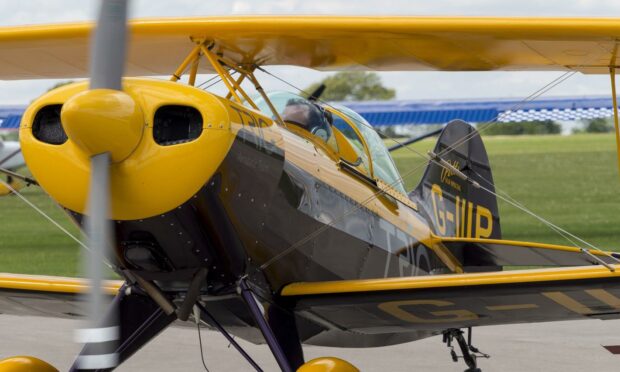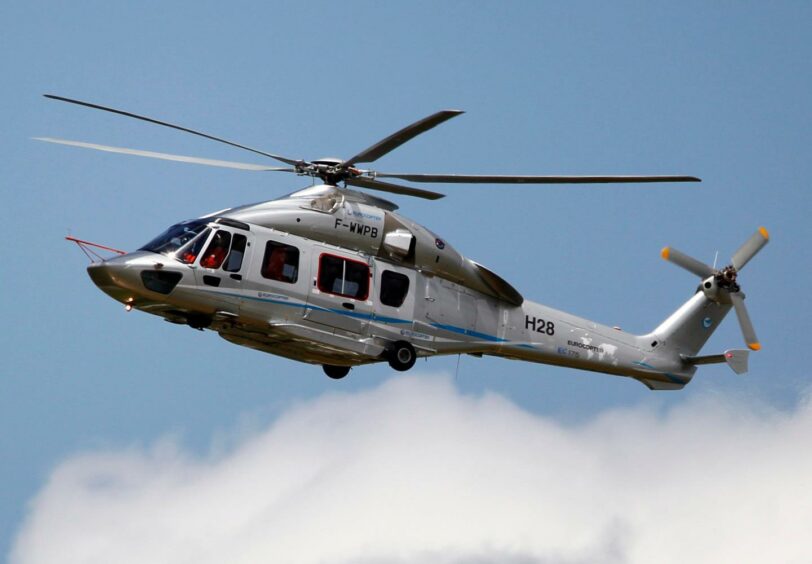A biplane performing “random” acrobatics and a helicopter were just 30 seconds away from colliding over Tayside, an official probe has revealed.
The pilot of the Eurocopter EC175 was inbound to Dundee.
But when in the descent at 3,600ft – and about eight nautical miles to runway – his collision warning system activated.
About 500ft below, climbing at greater than 500 feet per minute – and within three nautical miles – was the biplane.
The pilot’s report, summarised by the UK Airprox Board, which investigates near misses, said: “The target was visually acquired climbing rapidly and crossing from left to right. It looked to turn towards them before then initiating a dive and slight turn away toward the 1 o’clock.
“It then pulled back up again before a wing-over to its right that put it passing down the right hand side at approximately a half mile.”
‘Within 30 seconds of a collision’
Avoiding action was taken but “the crew considered a horizontal turn away from the conflict as ‘Resolution Advisory (RA) was working hard’ to react to a rapidly changing situation,” said the report.
“At one stage the crew was worried about an actual collision – and unsure whether this was the RA target.
“The risk assessment was medium to high.
“Traffic Alert and Collision Avoidance System (TCAS) RA indicates that they were within 30sec of a collision and both the system and crew were working hard to formulate a plan to cope with a fast manoeuvring aircraft flying seemingly random aerobatics.
“It was hard to judge whether the other pilot gained visual contact.
“Although, in retrospect, the risk of impact whilst the aircraft was flying an RA could be judged to be medium, if they were not TCAS equipped and/or the other aircraft had no transponder, the outcome may have been different.
“The only traffic Dundee was aware of (and of which they had been informed), was an aircraft in the circuit at Perth at 1,000ft.”
Risk of collision
The helicopter pilot assessed the risk of collision as “High”.
The pilot of the Pitts biplane did not submit an Airprox report but provided a narrative account of the event in which they reported undergoing training for aerobatics to the northwest of Scone aerodrome.
When climbing to gain height they observed a helicopter transiting from left to right, in a southerly direction, maintaining speed on a straight and level course.
They discontinued the exercise until the helicopter had passed, at approximately 800m ahead.
“At no time did they consider it a threat, and carried on with the exercise afterwards,” said the report.
“The pilot assessed the risk of collision as ‘None’.”
‘Missed opportunity’
The airprox board said that Dundee does not have a radar and the Dundee controller consequently had no situational awareness on the position of the Pitts and therefore could not detect a potential conflict or pass traffic information.
The board wondered why the Perth operator did not inform the Dundee controller of the Pitts conducting aerobatics to the north of Perth during a telephone call and thought this was “a missed opportunity” to increase pilot and controller situational awareness.
The board said: “Turning to the pilots’ actions; the Pitts pilot had no situational awareness on the closing EC175 and the EC175 pilot only had a degree of late situational awareness provided by their TCAS display and Traffic Alert.
“Members agreed that both pilots were entitled to be operating where they were.
“They also agreed that the EC175 pilot was constrained in operating area, to a degree, by the requirements of the….approach and felt that the Pitts pilot, not being so constrained, may have been able to plan to operate in an area that would not have presented a potential confliction.
“This would of course have required knowledge of the Dundee….approach track and the board wondered to what degree pilots operating from Perth were aware of such.
“The board thought that the Pitts pilot may also have been better served by contacting Dundee to pass their position and intentions and perhaps receive traffic information on inbound Instrument Flight Rules traffic.
“In the event, the EC175 pilot received a TCAS TA and RAs, the latter coupled to the autopilot which resulted in various climbs and descents.
“Members agreed that this was no doubt alarming but also that TCAS is not designed to provide collision avoidance from another aircraft that is flying aerobatics.
“Given that each pilot saw the other aircraft before closest point of approach (CPA) and that both pilots estimated a similar separation at CPA of about ½ mile, the board felt that although safety may have been degraded, there was no risk of collision.”
The incident was given a risk rating of C.











